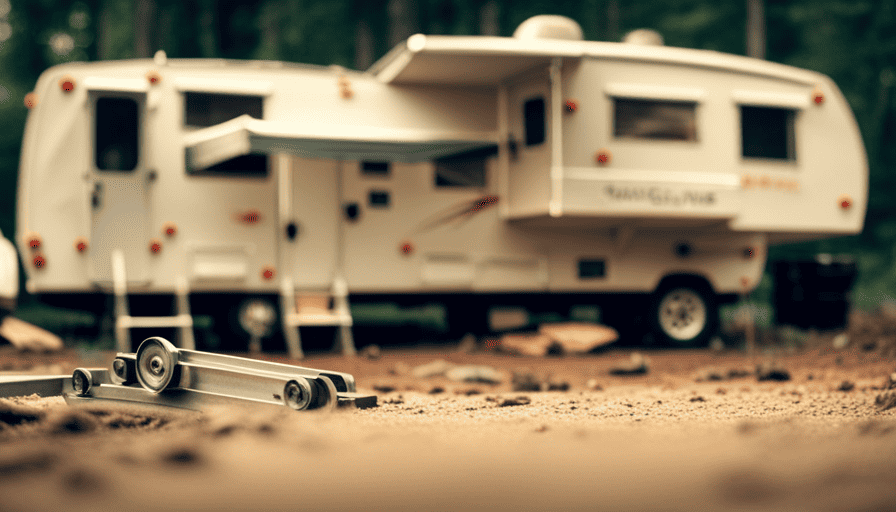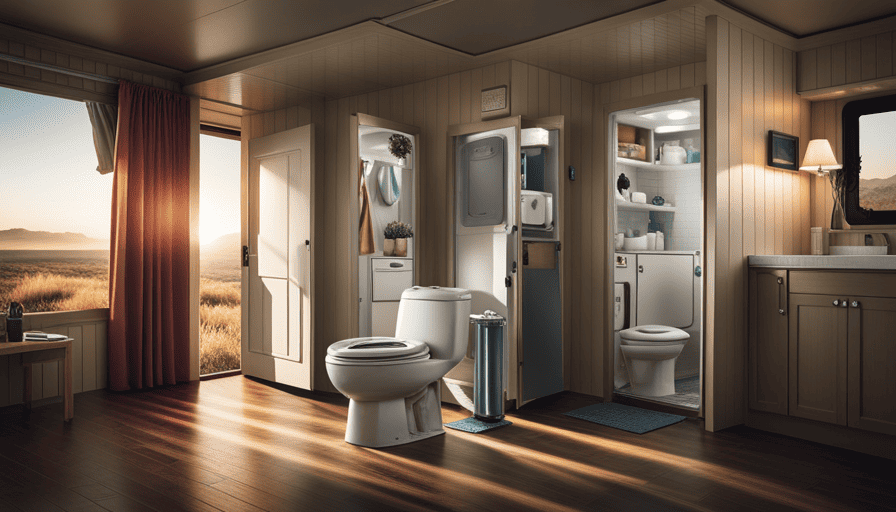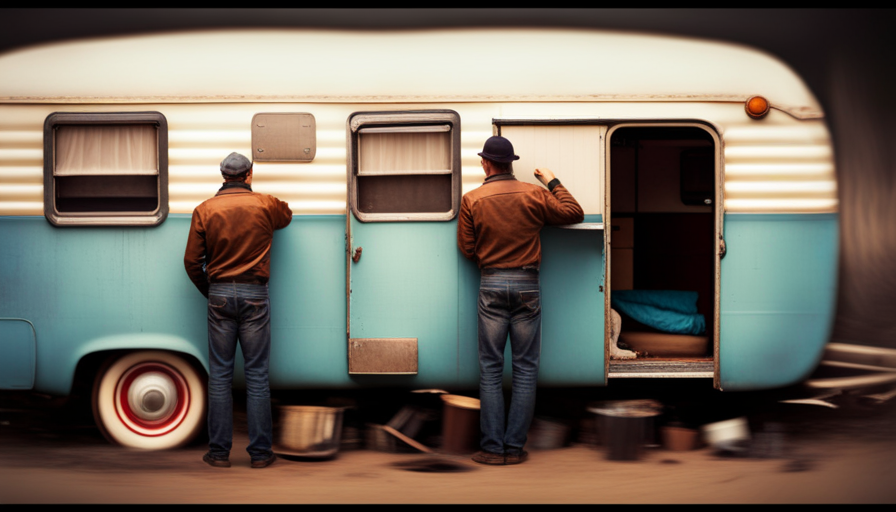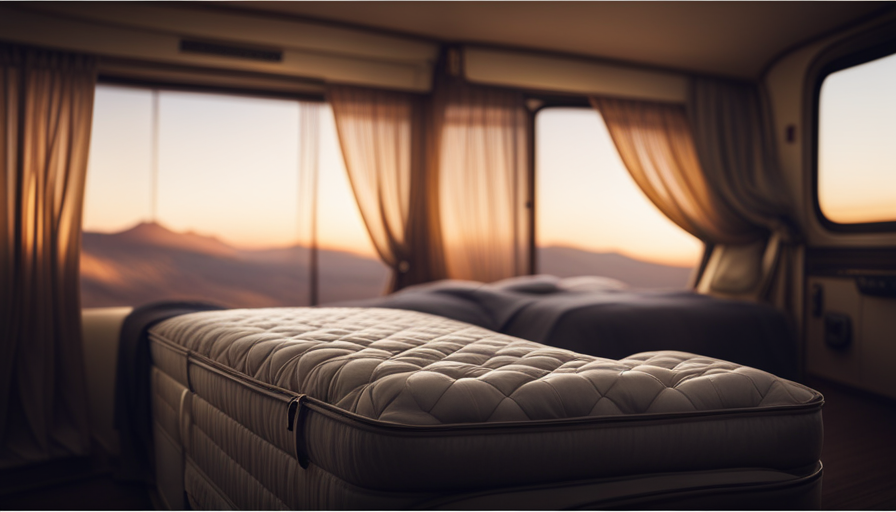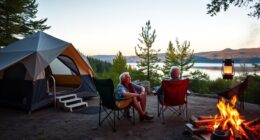You think you’ve found the perfect spot to park your camper for a peaceful getaway. But as soon as you step inside, the rocking begins. It’s like being on a never-ending roller coaster ride, except you’re not exactly thrilled about it.
Well, fear not my fellow camper enthusiasts, because I’ve got some tricks up my sleeve to help you keep that camper from rocking and rolling like a wild rodeo bull.
In this article, I will share with you some practical and detailed techniques that will make your camping experience a whole lot more stable and enjoyable. From leveling your camper properly to investing in stabilizing devices, we’ll cover it all.
And don’t worry, I won’t leave you hanging when it comes to reducing interior movement and securing those pesky exterior components.
So, buckle up and get ready for a smooth and steady ride. We’re about to turn that rocking camper into a sanctuary of tranquility.
Let’s dive in and discover how to keep your camper from rocking.
Key Takeaways
- Level the camper using a bubble level or smartphone app
- Use stabilizing jacks and devices to enhance stability and reduce swaying motion
- Secure loose items inside the camper to prevent movement
- Seek advice from experienced individuals and online resources for safe towing experience
Level Your Camper Properly
Want to keep your camper from rocking? Learn how to level it properly! Proper leveling techniques are essential for a stable and comfortable camping experience.
One common mistake in leveling is relying solely on the camper’s built-in leveling system. While these systems can be helpful, they’re not always accurate, especially on uneven terrain.
To ensure proper leveling, start by parking your camper on a level surface. Use a bubble level or smartphone app to check for any side-to-side or front-to-back imbalances. Adjust the leveling jacks or blocks accordingly, making small adjustments until the camper is perfectly level.
Another mistake to avoid is neglecting to chock the wheels. Chocks prevent the camper from rolling when you’re inside, adding an extra level of stability.
Once your camper is level, use stabilizing jacks to further minimize rocking. Stabilizing jacks should be placed near the corners of the camper and tightened until they’re securely in place.
With proper leveling and the use of stabilizing jacks, you can enjoy a rocking-free camping experience that feels just like home.
Use Stabilizing Jacks
To prevent any unwanted swaying, simply deploy the stabilizing jacks and watch as your camper stands firm like a steadfast mountain. Here are a few tips to ensure optimal stability:
-
Use chocks: Place wheel chocks on both sides of each tire to prevent any rolling or shifting. This will add an extra layer of stability and keep your camper in place.
-
Adjust tire pressure: Check the recommended tire pressure for your specific camper model. Properly inflated tires will distribute the weight evenly and minimize any rocking motion.
-
Extend stabilizing jacks evenly: Extend the stabilizing jacks on all four corners of your camper, making sure they’re extended evenly. This will provide a solid foundation and minimize any potential rocking.
-
Tighten stabilizing jacks: Use a wrench or a crank handle to tighten the stabilizing jacks until they’re firmly in place. This will further enhance stability and eliminate any wobbling.
By following these steps and incorporating chocks and properly adjusted tire pressure, you can ensure a stable and enjoyable camping experience. However, if you want to take your camper’s stability to the next level, it may be worth considering investing in stabilizing devices. These devices can provide additional support and minimize any rocking, giving you peace of mind during your camping adventures.
Invest in Stabilizing Devices
Consider investing in stabilizing devices to enhance the stability of your camper. Did you know that using stabilizing devices can reduce the swaying motion of your camper by up to 90%?
When it comes to anchoring your camper, using stabilizing devices is essential. These devices are designed to prevent your camper from rocking and swaying, providing a more stable and comfortable experience.
There are various types of stabilizing devices available in the market. One popular option is the stabilizing jack, which is installed on each corner of the camper. These jacks can be easily adjusted to level your camper and provide additional stability.
Another option is the stabilizing tripod, which provides support to the front end of the camper, reducing the movement caused by people walking inside.
Investing in stabilizing devices offers several benefits. Firstly, it enhances your safety by preventing excessive rocking, making it less likely for your camper to tip over. Secondly, it improves the overall comfort of your camping experience, as you can enjoy a stable and secure environment. Lastly, it helps to protect your camper from wear and tear caused by constant movement.
By using stabilizing devices, you can significantly reduce the swaying motion of your camper and create a more stable environment.
In the next section, we will explore ways to further reduce interior movement without compromising on comfort.
Reduce Interior Movement
Ready to experience a smoother ride inside your camper? Let’s explore ways to minimize interior movement and enhance your comfort. Here are some practical tips to help you achieve just that:
-
Install shock absorbers: Upgrade your camper’s suspension system with shock absorbers to reduce vibrations and improve stability, providing a more comfortable and steady ride.
-
Use anti-sway bars: Connect the camper’s chassis to the towing vehicle with these devices, minimizing side-to-side movement and enhancing control while on the road.
-
Secure loose items: Make sure to securely fasten any loose items inside your camper. This will prevent them from shifting around during travel and causing unnecessary movement.
-
Anchor the camper: Use stabilizing jacks or leveling blocks to help anchor your camper to the ground, reducing rocking and swaying.
By implementing these measures, you can significantly minimize vibrations and interior movement, ensuring a smoother and more comfortable ride. Now, let’s move on to the next section and learn about how to distribute weight evenly for further stability.
Distribute Weight Evenly
Ensure a smooth and stable ride inside your camper by evenly distributing weight, like a skilled tightrope walker finding perfect balance. Proper weight distribution is crucial for maintaining balance and preventing your camper from rocking excessively.
When loading your camper, pay attention to where you place heavy items such as furniture, appliances, and water tanks. These should be distributed evenly on both sides of the camper to avoid creating an imbalance. Additionally, make sure to secure these items properly to prevent them from shifting during travel.
To distribute weight evenly, start by placing heavy items in the center of the camper, close to the axles. This will help maintain balance and prevent swaying. It’s also a good idea to store heavy items low to the ground, as this will further enhance stability. Use leveling blocks or jacks to adjust the height of your camper and ensure it is level before hitting the road.
By following these weight distribution techniques, you can minimize the movement inside your camper and enjoy a more comfortable ride. Once you’ve mastered the art of weight distribution, it’s time to move on to the next step: choosing a stable campsite.
Choose a Stable Campsite
Finding a stable campsite can make all the difference in creating a peaceful and enjoyable camping experience. When it comes to campsite selection, there are a few key factors to consider in order to minimize environmental factors and ensure a stable setup.
-
Look for level ground: Choosing a campsite with level ground is essential for preventing your camper from rocking. Uneven terrain can cause instability and make it difficult to keep things balanced inside. Take the time to find a spot that offers a flat surface for your camper.
-
Avoid areas with loose soil: Loose soil can lead to sinking and shifting, which can make your camper rock. Opt for campsites with solid ground or compacted soil to provide a stable foundation for your setup.
-
Seek sheltered spots: Wind can significantly impact the stability of your camper. Look for campsites that offer natural windbreaks, such as trees or rock formations, to provide added stability and minimize the rocking caused by gusts.
By carefully selecting a stable campsite, you can minimize the risk of your camper rocking and ensure a comfortable camping experience.
In the next section, we’ll explore how to secure exterior components to further enhance stability and reduce movement.
Secure Exterior Components
To enhance stability and minimize movement, it’s important to secure the exterior components of your camper. By utilizing anchoring techniques and reinforcing the exterior components, you can ensure that your camper stays steady and secure, even in windy conditions or on uneven terrain.
One effective anchoring technique is to use sturdy stakes or anchors to secure the camper’s corners. These can be driven into the ground and attached to the camper’s frame, providing additional stability.
Additionally, using straps or tie-downs to secure the camper to nearby trees or fixed objects can further prevent rocking and shifting.
Reinforcing the exterior components of your camper is also crucial in minimizing movement. Check for any loose or weak areas and make necessary repairs. Reinforce the corners and seams of your camper with additional hardware or sealant to ensure they stay intact.
Additionally, consider installing stabilizer jacks or leveling blocks to provide extra support and prevent swaying.
By properly anchoring and reinforcing the exterior components of your camper, you can significantly reduce movement and rocking. This not only enhances stability but also promotes a more comfortable camping experience.
Now, let’s explore ways to limit movement inside the camper.
Limit Movement Inside the Camper
Minimizing movement inside the camper is key to creating a truly serene and stable camping experience. When it comes to minimizing vibration and preventing shifting, there are a few practical steps you can take.
Firstly, it’s important to secure loose items inside the camper. This includes everything from kitchenware to personal belongings. Storing items in cabinets with latches or using non-slip mats can help keep them in place during travel. Additionally, consider using bungee cords or cargo nets to secure larger items such as bicycles or coolers.
Another way to limit movement inside the camper is by using furniture straps. These can be attached to the walls and used to secure items such as tables and chairs. By anchoring them down, you can prevent them from sliding or tipping over while on the road.
Lastly, consider using anti-sway bars or weight distribution hitches. These devices can be installed on the camper’s hitch and help distribute the weight evenly, reducing the side-to-side movement. This not only improves stability but also minimizes the rocking motion inside the camper.
By taking these steps to limit movement inside the camper, you can create a more enjoyable and stable camping experience. Now, let’s explore the next section on how to use anti-sway bars or weight distribution hitches to further enhance your camper’s stability.
Use Anti-Sway Bars or Weight Distribution Hitches
Enhance your camper’s stability by utilizing anti-sway bars or weight distribution hitches, which effectively reduce side-to-side movement and create a smoother and more secure travel experience. Here are some key benefits of using anti-sway bars:
-
Improved control: Anti-sway bars help in distributing the weight evenly between the camper and the towing vehicle, reducing the chances of swaying while driving. This improves overall control and handling, especially when encountering strong crosswinds or passing large vehicles.
-
Enhanced safety: By minimizing side-to-side movement, anti-sway bars help to prevent accidents caused by trailer sway. This is particularly important when driving on winding roads or during emergency maneuvers.
-
Reduced wear and tear: Excessive rocking and swaying can cause strain on the camper’s frame, tires, and suspension system. By using anti-sway bars, you can reduce the wear and tear on these components, resulting in longer-lasting and more reliable equipment.
-
Increased comfort: Traveling in a camper that is constantly rocking can be uncomfortable and tiring. Anti-sway bars help to create a more stable environment, allowing you to enjoy a smoother and more comfortable ride.
When installing weight distribution hitches, ensure that they’re properly aligned and adjusted to achieve optimal weight distribution between the towing vehicle and the camper. Seek professional help if needed to ensure correct installation and setup, as this can greatly impact the effectiveness of the weight distribution system. Transitioning to seeking professional help if needed, it’s important to remember that safety should always be a priority when towing a camper.
Seek Professional Help if Needed
If you’re unsure about proper installation or adjustment, don’t hesitate to seek professional help to ensure your camper is safely towed. Seeking advice from a professional can provide you with the expertise and guidance you need to properly stabilize your camper and prevent it from rocking during travel. They can help you determine if there are any specific issues with your camper or if there are any adjustments that need to be made to improve stability.
In addition to seeking professional help, there are also online resources available that can provide valuable information and guidance on how to keep your camper from rocking. These resources often include step-by-step instructions, videos, and forums where you can ask questions and get advice from experienced campers and experts in the field.
When seeking advice online, it’s important to consider the credibility of the source and to verify the information provided. Look for reputable websites and forums that are frequented by knowledgeable individuals who have experience in towing and stabilizing campers.
By seeking professional help and utilizing online resources, you can gain the knowledge and confidence needed to properly stabilize your camper and enjoy a smooth and safe towing experience.
Frequently Asked Questions
How much weight can stabilizing jacks support?
The weight capacity of stabilizing jacks can vary depending on the specific model and manufacturer. To determine the weight limit of your stabilizing jacks, refer to the product manual or contact the manufacturer directly.
It’s crucial to ensure that the jacks can support the weight of your camper to prevent any accidents or damage. Always prioritize safety and follow the guidelines provided by the manufacturer for proper usage and weight limits.
Are stabilizing devices necessary for all types of campers?
Stabilizing techniques aren’t necessary for all types of campers. The need for stabilizing devices depends on the specific design and weight distribution of the camper.
Some campers are inherently more stable and don’t require additional support. However, if your camper tends to rock, there are alternative solutions to consider. These may include using stabilizing jacks, leveling blocks, or wheel chocks to provide stability and minimize rocking.
What are some common reasons for interior movement in a camper?
Common reasons for interior movement in a camper include uneven terrain, high winds, and sudden stops. To prevent this, camper stabilization techniques are crucial. These include using stabilizing jacks, leveling blocks, and wheel chocks to create a stable foundation.
Additionally, distributing weight evenly throughout the camper and securing loose items can minimize movement. Regular maintenance of suspension and tires is also important. By implementing these practical strategies, you can enjoy a more stable and comfortable camping experience.
How do anti-sway bars or weight distribution hitches work?
Anti-sway bars, also known as sway control bars, help minimize the swaying motion caused by crosswinds or passing vehicles. They connect the camper’s frame to the tow vehicle, providing added stability and preventing excessive rocking.
Weight distribution hitches evenly distribute the weight between the tow vehicle and the camper, ensuring proper balance and reducing the risk of rocking or swaying.
Proper installation of these devices is crucial for their effectiveness.
What are some signs that indicate the need for professional help in stabilizing a camper?
Oh boy, let me tell you, there are some surefire signs that your camper needs professional help in the stability department.
If you find your camper swaying like a drunken sailor on the high seas, or if it starts doing its own little dance every time you step inside, it’s time to wave the white flag and call in the experts.
Don’t wait until your camper decides to take a tumble, get that professional help ASAP and keep your wheels firmly on the ground.
Conclusion
In conclusion, keeping your camper from rocking is essential for a comfortable and enjoyable camping experience. By following these practical tips, such as leveling your camper properly, using stabilizing jacks, and investing in stabilizing devices, you can greatly reduce the movement and rocking of your camper.
Additionally, distributing weight evenly, securing exterior components, and limiting movement inside the camper are crucial steps. For added stability, consider using anti-sway bars or weight distribution hitches. Remember, seeking professional help if needed is always an option.
So, go ahead and implement these techniques to ensure a smooth and steady camping adventure.

